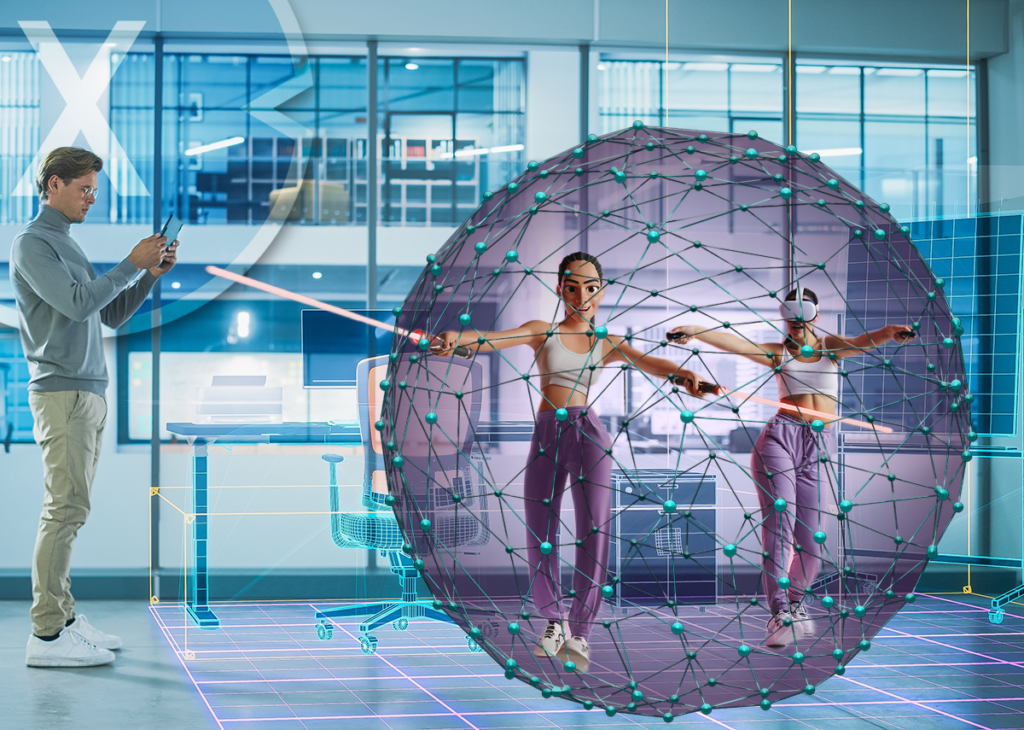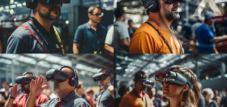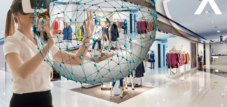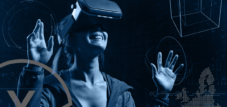Hybrid Messe & Event: Cross-device 'Free Device' Reality with XR technology (extended, augmented, mixed & virtual)
Language selection 📢
Published on: October 20, 2023 / Update from: October 20, 2023 - Author: Konrad Wolfenstein
🌐 Cross-device 'Free Devices' for a Smart Metaverse with XR technology at and for hybrid trade fairs and events
In recent years, the technologies around the metaverse and extended reality (XR) have developed quickly and are slowly but surely becoming increasingly an integral part of trade fairs and events. A particularly fascinating innovation is the idea of cross -device 'Free Devices'. This is about the possibility of freely selecting different devices for access to the meta verse and the XR environment. Whether smartphone, VR glasses, tablet, computer or a touchscreen on the wall or as a table-the choice of the device is with the user. This flexible approach enables a unique hybrid trade fair idea, in which digital and real experiences melt seamlessly.
🌍 The importance of the Metaverse and extended reality at trade fairs and events
Before we delve deeper into cross-device free devices, it is important to understand the metaverse and extended reality as it relates to trade fairs and events. The Metaverse is a virtual world in which users can interact using digital avatars. It offers a comprehensive digital environment ranging from social media to gaming to business applications. Extended Reality (XR), on the other hand, is a collective term that includes Augmented Reality (AR), Virtual Reality (VR) and Mixed Reality (MR). XR expands the physical world with digital elements and enables immersive experiences.
Trade fairs and events are traditionally places for personal exchange and business initiation. However, with the integration of the Metaverse and XR technologies, they take on a completely new dimension. Trade fairs can now also be held digitally and in combination, thereby overcoming physical distances. This enables companies to take part in trade fairs worldwide without being physically there. At the same time, physical trade fairs can also be expanded with XR areas that offer additional information and experiences.
🚀 The advantages of cross-device free devices
The idea of cross-device free devices brings numerous advantages that significantly improve the experience at trade fairs and events in the Metaverse and the XR environment:
1. Flexibility for participants
Each participant can choose the device that best suits their needs and preferences. Some may prefer the immersion of VR glasses, while others prefer to navigate on their tablet or smartphone. This freedom increases the willingness to participate and the well-being of the participants.
2. Cost effectiveness
Because participants can use their own devices, the cost of providing expensive hardware is eliminated. This significantly reduces entry and participation costs for trade fairs and events and also enables smaller companies and individuals to take part in events.
3. Accessibility
The cross-device approach takes the diversity of users into account. People with different abilities and needs can use the devices most suitable for them, increasing accessibility and creating a more inclusive environment.
4. Seamless integration
Integrating various devices into the Metaverse and XR environment requires advanced technologies that enable seamless interactions. This encourages collaboration between participants and enables a seamless experience.
5. Realistic experiences
The combination of digital and real elements enables realistic experiences. For example, participants can use VR glasses to inspect virtual products or take part in interactive presentations while being physically present at the same time.
🌟 Application scenarios for cross-device free devices at trade fairs and events
In order to fully exploit the advantages of cross-device free devices at trade fairs and events, various application scenarios can be considered:
1. Hybrid trade fairs
At hybrid trade fairs, participants can be on site or participate digitally from anywhere in the world. This opens up the opportunity for companies to reach a broader audience while enabling physical interactions.
2. 3D product presentations
Companies can showcase their products in virtual environments, allowing them to capture attendees' attention and provide them with realistic insights into the products. This is particularly relevant in industries such as real estate, automotive and fashion.
3. Networking and social interaction
The cross-device free devices enable participants to network in virtual lounges and maintain social interactions. This creates an informal atmosphere that comes close to the personal exchange at physical trade fairs.
4. Virtual conferences and lectures
Keynote speakers and experts can deliver their presentations in a VR environment to create an interactive and immersive experience. Participants can ask questions and respond in real time as if they were physically present.
5. Measuring engagement
XR technology allows event organizers to accurately measure attendee engagement. You can track which presentations received the most attention, which products were clicked on the most, and which interactions occurred the most.
🛠️ Challenges and future developments
Although the idea of cross-device free devices is promising, there are also some challenges to be overcome:
1. Technological compatibility
The integration of different types of devices requires advanced technological solutions to ensure interoperability. This requires close collaboration between hardware manufacturers and software developers.
2. Privacy and Security
The use of personal devices in XR environments can raise privacy and security concerns. It is crucial to implement robust security protocols to protect user privacy.
3. User Experience
The user experience must be consistent and engaging across different devices. This requires careful design of XR environments and optimization for different screen sizes and input methods.
The future of cross-device free devices at trade fairs and events looks promising. As technology advances, these challenges will be overcome and XR will become an integral part of the events industry. Companies should use these opportunities to expand their audience, merge real and virtual worlds, and create an innovative experience for their participants.
📝 Free choice and accessibility with the Free Devices concept
The cross-device free devices in the context of the Metaverse and Extended Reality (XR) at trade fairs and events offer numerous advantages, including flexibility, cost efficiency and accessibility. They allow participants to freely select different types of devices to seamlessly connect digital and real experiences. This technology opens up application scenarios such as hybrid trade fairs, product presentations, virtual conferences and networking in virtual lounges. Although there are challenges, the use of XR technologies across devices is expected to shape the future of the events industry and significantly expand opportunities for businesses.
📣 Similar topics
- 🔮 The future of the trade fair world: Cross-device XR technology
- 🌐 Virtual and real fusion: The metaverse at trade fairs
- 🚀 The revolution of the event industry: XR and free devices
- 💼 XR in the business world: opportunities and challenges
- 📈 Hybrid trade fairs of the future: Flexibility through free devices
- 🌟 The magic of XR: New dimensions for events
- 💰 Cost efficiency and diversity: Cross-device free devices
- 🤝 Virtual networking: XR lounges at trade fairs
- 🎉 Immersive product presentations: XR in focus
- 📊 Measuring success in XR: analyzing participant engagement
#️⃣ Hashtags: #Metaverse #XR #MessenUndEvents #FreeDevices #Innovation
🌐 Hybrid trade fairs and events have become increasingly important in today's digital world
In this context, XR technology (extended reality) is increasingly used, which includes expanded, augmented, mixed and virtual reality. These technologies revolutionize the way trade fairs and events are designed and offer a cross -device 'Free device' concept that raises the interaction and commitment of the participants to a new level.
📱🕶️🎮 XR technology at a glance
1️⃣ Augmented Reality (AR)
Augmented Reality inserts digital content, such as 3D models, information or animations, into the real world. This is often done using smartphones or AR glasses. AR can be used, for example, for interactive product presentations at trade fairs.
2️⃣ Virtual Reality (Virtual Reality – VR)
Virtual reality completely immerses users in a digital environment that is separate from the real world. This is often achieved with VR glasses and enables immersive experiences. At trade fairs, VR applications can be used for product presentations or virtual tours.
3️⃣ Mixed Reality (MR)
Mixed reality combines elements of the real and virtual world, integrating digital objects into the real environment. This allows users to interact with the digital content as if it were physically present. Microsoft HoloLens is an example of MR glasses.
4️⃣ Augmented Reality (Extended Reality – XR)
XR is the umbrella term that summarizes all of these technologies. It includes AR, VR and MR and therefore offers a wide range of possibilities for immersive experiences and applications.
📱🕶️🎮 The concept of cross -device 'Free device'
1️⃣ Across devices
The 'Free Device' concept enables the participants to use XR technology on various devices. This can range from smartphones to tablets to special AR and VR glasses. The diversity of the supported devices extends the range of the event and enables a wider audience to take part.
2️⃣ Free access
The term 'free device' means that the participants are offered the use of XR technology free of charge. This can help to reduce the hurdles for participation in hybrid measurement and reduce events and to increase the interest of the potential participants.
3️⃣ Interactive experiences
XR technology enables interactive experiences in which participants are not just spectators, but are actively involved in the event. You can view products in AR, explore virtual spaces or interact in MR environments. This increases participant engagement and attention.
4️⃣ Customizability
The 'Free Device' concept can be adapted to the needs and goals of the trade fair or event. Depending on the event, various XR technologies can be used to create the desired experiences.
📱🕶️🎮 Applications of XR in hybrid trade fairs and events
1️⃣ Product presentations
Companies can showcase their products in AR or VR, allowing participants to have an immersive experience and learn about the products in a virtual environment.
2️⃣ Virtual tours
Trade fairs and events can offer virtual tours where participants can move around in a digital environment and explore stands or venues as if they were physically there.
3️⃣ Interactive training and workshops
XR technology makes it possible to make training and workshops more interactive and engaging. Participants can learn and carry out practical exercises in a virtual environment.
4️⃣ Networking
Virtual networking platforms in VR or MR offer the opportunity to interact with other participants in real time, have conversations and make contacts as if they were there in person.
5️⃣ Measurement data and analysis
XR technology makes it possible to collect and analyze data about participants' behavior. This can provide event organizers with valuable insights into attendee interactions and interests.
🚀📈 Examples of success
1️⃣ Automotive industry
Car manufacturers are using AR and VR to provide virtual vehicle configurators. Participants can assemble and explore their dream cars in a virtual environment.
2️⃣ Real estate industry
Real estate fairs offer virtual tours of houses and apartments. Interested parties can view the properties virtually before opting for a physical viewing.
3️⃣ Education
Education fairs and conferences use XR technology to create virtual classrooms or laboratories. This enables participants to experience educational institutions and offerings up close.
4️⃣ Art and culture
Museums and cultural events use MR to transform works of art and historical sites into an immersive experience. Visitors can immerse themselves in history and view works of art from different perspectives.
🚀🤝Challenges and future outlook
Although the use of XR technology in hybrid trade fairs and events offers many advantages, there are also some challenges to overcome. These include the cost of developing XR applications, the need for a stable internet connection for participants, and integrating the technology into existing event platforms.
However, the future of XR technology in the event industry looks promising. As AR, VR and MR continue to evolve, immersive experiences are becoming even more immersive and accessible. Companies and event organizers that invest in XR can differentiate their events and appeal to a broader audience.
Overall, XR technology offers exciting potential for the transformation of hybrid trade fairs and events. It opens up new opportunities for interactive experiences, product presentations and networking that inspire participants and turn events into unforgettable experiences.
🌐 Hybrid trade fair with metaverse and physical trade fair, in-house exhibition or event – suitable for global, cross-border events
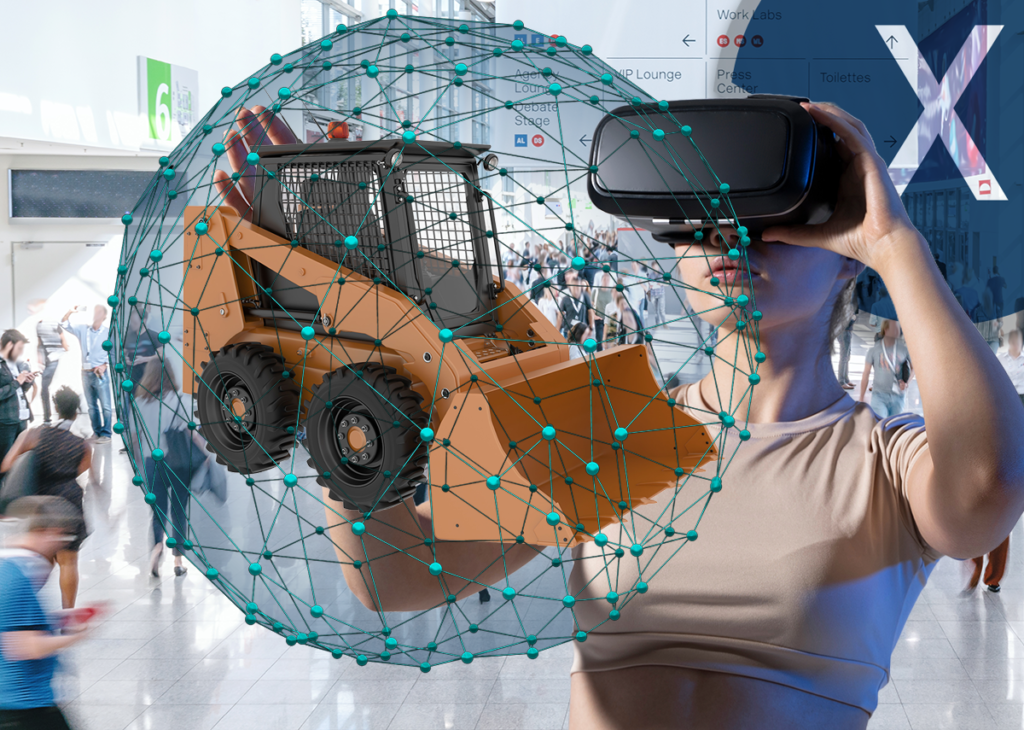
Hybrid trade fair with metaverse and physical trade fair, in-house exhibition or event – Image: Xpert.Digital
The advantages of 3D product presentations in the Metaverse in combination with physical trade fairs and events, also used as a hybrid trade fair, are diverse and can help companies strengthen their presence in the market and create an impressive customer experience.
More about it here:
Although trade shows and other in-person promotional events have faced strong competition from digital marketing channels in recent years, they remain among the most profitable business-to-business (B2B) media strategies around the world. In 2019, the global B2B trade fair market was valued at $34.4 billion, and by 2023 this number is expected to exceed 40 billion.
More about it here:
🗒️ Xpert.Digital: A pioneer in the field of extended and augmented reality
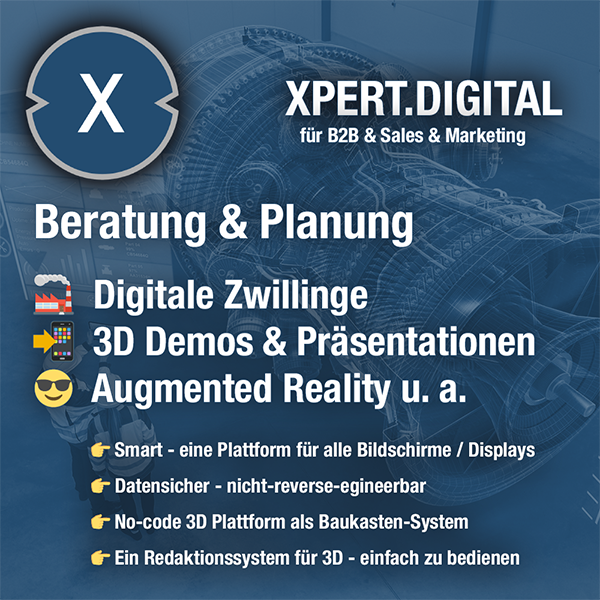
We are there for you - advice - planning - implementation - project management
Xpert.Digital - Pioneer Business Development
Smart Glasses & KI - XR/AR/VR/MR industry expert
Consumer metaverse or meta -verse in general
If you have any questions, further information and advice, please feel free to contact me at any time.
I would be happy to serve as your personal advisor.
You can contact me by filling out the contact form below or simply call me on +49 89 89 674 804 (Munich) .
I'm looking forward to our joint project.
Xpert.Digital - Konrad Wolfenstein
Xpert.Digital is a hub for industry with a focus on digitalization, mechanical engineering, logistics/intralogistics and photovoltaics.
With our 360° business development solution, we support well-known companies from new business to after sales.
Market intelligence, smarketing, marketing automation, content development, PR, mail campaigns, personalized social media and lead nurturing are part of our digital tools.
You can find out more at: www.xpert.digital - www.xpert.solar - www.xpert.plus




